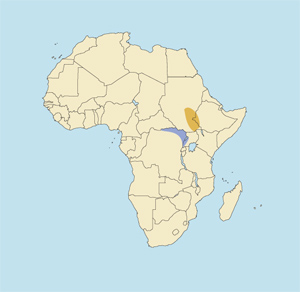 |
 |
Kobus kob leucotis
Cobe aux oreilles blanches (F).
DESCRIPTION Shoulder height 35 inches (89 cm). Weight 180 pounds (82 kg).
The white-eared kob is somewhat larger in body and horns than the western kob, but is about the same size as the Uganda kob. It has the most distinctive appearance of any kob. Adult males have entirely white ears, conspicuous white rings around the eyes, white patches on throat and upper neck, and white underparts.
With age, most males develop a darker color that spreads from the forehead and sides of the face to the entire upper body. Some individuals are almost black except for the vividly contrasting white markings, and are spectacularly handsome. Females and young males are chestnut red with the backs of the ears buff.
The darkest-colored males are found on the East Bank of the White Nile, but those with the longest horns are from the West Bank.
BEHAVIOR The white-eared kobs on the East Bank of the White Nile undergo one of the largest migrations still taking place in Africa, the annual trek of nearly one million animals from dry season range to wet season range and back again. Those on the West Bank are non-migratory.
DISTRIBUTION Southern Sudan on both sides of the White Nile, and the Gambella region of extreme western Ethiopia. Individuals or small groups occasionally wander into northern Uganda.
TAXONOMIC NOTES In a 1988 work, Hillman & Fryxell limit the white-eared kob to the East Bank of the Nile and classify all kobs from the West Bank as Uganda kob. This concept is appealing in its simplicity and would make record keeping easier if it were so, but we think the situation is more complex than that. Many West Bank kobs exhibit the white-eared kob characteristics of a dark, brownish-black body and vivid white markings that include totally white ears. It seems absurd to call such animals anything but white-eared kobs. However, in the same areas, one can observe other adult males with reddish or yellowish coats, less extensive white markings on face and throat, and backs of ears that are tan and white or all tan.
It seems to us that the region west of the Nile in Sudan is a huge intergrade zone between white-eared and Uganda kobs in the east and south, and white-eared and western kobs in the far west. We think that most West Bank kobs should probably be classified as white-eared kobs, even though many are not as dark-bodied as East Bank specimens. There also are animals in eastern and southern areas of the West Bank that fit the description for Uganda kob and should be classified as such, and there are specimens in the far west of Sudan that surely must be western kobs. But there also are many individuals with a bewildering variety of intermediate characteristics that are very difficult to classify, and for which we have no clear solution at this time.
|





